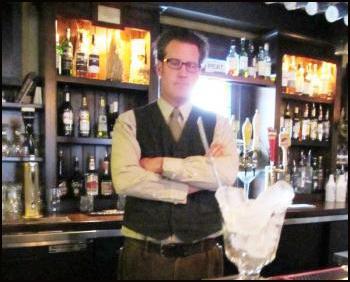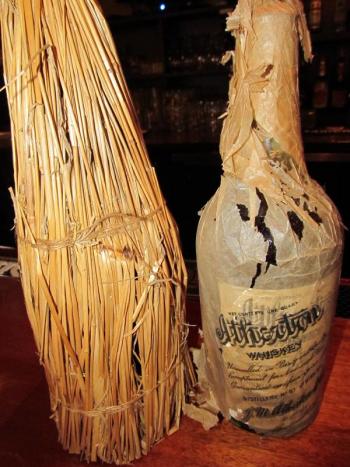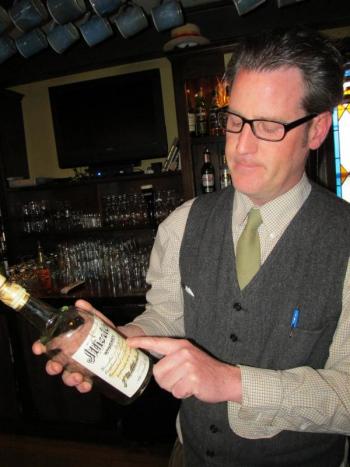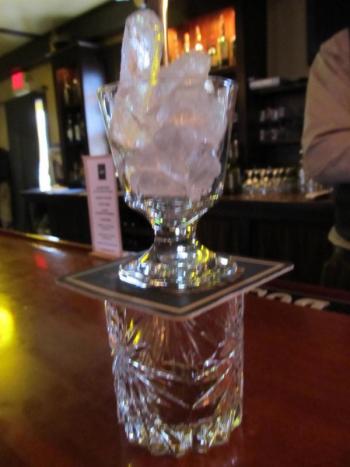What it’s like to sip a $150 glass of pre-Prohibition whiskey
THOMASTON - It’s a little like Christmas, at first. The thrill is in opening up an old wooden crate to find bottles packed in form-fitting straw encasements. What we have here is pre-Prohibition bourbon whiskey from 1907, an extremely rare find.
“I guess this is what you’d call turn-of-the-century bubble wrap,” said Chris Burke, owner of Billy’s Tavern in Thomaston, as he put a bottle of Atherton whiskey on the bar. Lifting the straw encasement off the bottle, he peeled away the thin, crumbling tissue sleeve. The fonts on the bottle’s label alone are retro enough to make any graphic designer giddy. The label’s writing says this whiskey has been aged four years, so its total age is 110 years.
“Whiskey only ages in barrels, but it can mellow over time in the bottle,” said Burke. “The flavors can change and become more complex."
Burke explained this was true Kentucky bourbon, named after the place it was made, in Athertonville, Kentucky. On the bottle it is labeled a whiskey, even though technically, because it is from Kentucky, it is a bourbon. Back then, the distilleries didn’t actually make the distinction — that came much later.
Burke, a die-hard whiskey enthusiast, grew up in Cincinnati, Ohio, right across the river to Covington, Kentucky. Kentucky is where all bourbons are made. Because bourbon was such a cultural fixture (as Allen’s Brandy is to Maine) Burke and his brother, Billy, were well versed in its taste.
“Bourbon has a very distinctive quality," he said. "Now I love single malt whiskey, but back in the ‘70s and ‘80s, most of what you would see were the Johnnie Walker Blacks and Reds, the Dewar’s, Famous Grouse — blended whiskies. Growing up on bourbon, these blended whiskies had this very cloying, thin, medicinal taste, so I stayed away from them."
When Burke was around 30 years old, his brother Billy introduced him to Lagavulin, a single malt whisky, which became Burke’s instant favorite.
“It is so smoky and peaty, it’s unbelievable,” he said. “At any rate, this Lagavulin had everything I hated about scotch, but it had such a preponderance of it, it took that thing I didn’t like and blew it up; so then I loved it.”
Because of the Lagavulin, Burke found himself immersed in the subject of whiskeys, reading about them, tasting them, and searching for them. This led him to finding the case of the pre-Prohibition Atherton whiskey. He won’t say where he purchased it or how much it cost (“it’s a trade secret") but he alludes to the fact that growing up where he did, he “knew what he had when he saw it.”
The label boasts: “Unexcelled in purity and quality. Exceptional for medicinal use.” In pre-Prohibition times, Burke said, distilleries would always make this kind of reference to a whiskey’s “medicinal use.”
“It’s very pretty old bottle,” he said. If you found a whiskey this rare, it would probably sell for $100 an ounce or around $150 per glass. Though he hasn’t sold the one empty bottle he now possesses, he said he’s seen them for sale for upwards of $500.
It’s time to taste it
But first, Burke takes me through a very detailed journey through the origins and regions of bourbon and whiskey. For the novice, a fine whiskey is like the cream that rises to the top. What makes old whiskey so expensive is that as much as 30 percent can be lost to evaporation (called “the angel’s share") depending on how long it has been aged. In the case of single malt whiskies, add to this the fact that only 10 percent of the whisky in Scotland is retained for bottling as single malts. The vast majority of the rest of it goes to making blended whisky, such as Dewar’s. (Note: for those of you spell-checking, whiskey is generally spelled with an "e," but in the case of Scotch whisky such as Dewar's, the "e" is dropped.)
Burke sets up a glass of ice atop an elegantly cut glass with a sip of the pale straw Atherton whiskey and gives me a glass of Old Grand Dad to try first as a base for comparison.
He coaches me to try it.
“First, when you’re smelling whiskey, it’s not like when you are smelling wine," he said. "The alcohol will fry your nose, so you’ve got to open your mouth when you smell it. You’ll feel a little silly, but you won’t get bombarded with the alcohol.”
As predicted, the Old Grand Dad, a solid, affordable staple, tastes oily, with some sweetness, some apple, and a lot of burn.
A sip of water to cleanse the palate, and now comes the Atherton.
“As you smell it,” Burke said, “ you’ll notice it smells lighter, sweeter, more fragrant.” The scent is much more sophisticated.
As I sip it, Burke helps put words to what I’m experiencing.
“It’s so soft, right? A tiny little spark on the back of your throat and then the flavor keeps coming,” he said. “Not a big alcohol punch, you don’t wince. It’s like a cognac.”
I try to hold onto this taste. I don’t know whether it’s because it is so old or so rare, but it is sublime.
“To me it’s like drinking Haley’s Comet,” he said. “You’re never going to run across this again.” He added, “I know of 10 other bottles from pre-Prohibition times that are in a private collection and I don’t know of any more.”
So what we’ve just had, maybe a few other people will taste in this lifetime. When it’s gone, it’s gone.
“There will be people who will seek this out, knowing what it is,” he said. “Anybody who hangs out here knows I love talking about whiskeys. One of my favorite things is to encourage people who think they don’t like whiskey to try it. You just have to find the right one and match it up to the person. I know I can turn them on to a whiskey they will love.”
Kay Stephens can be reached at news@penbaypilot.com



























